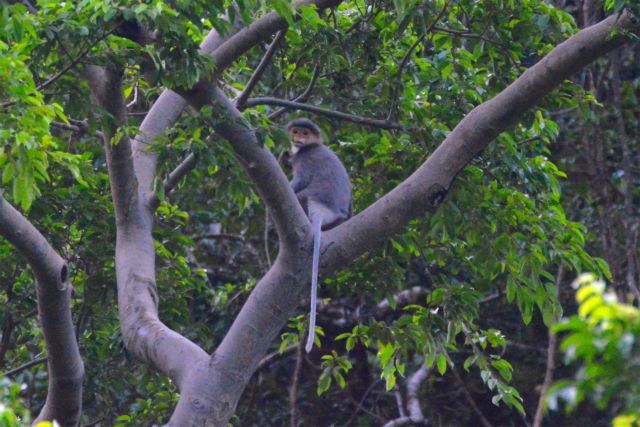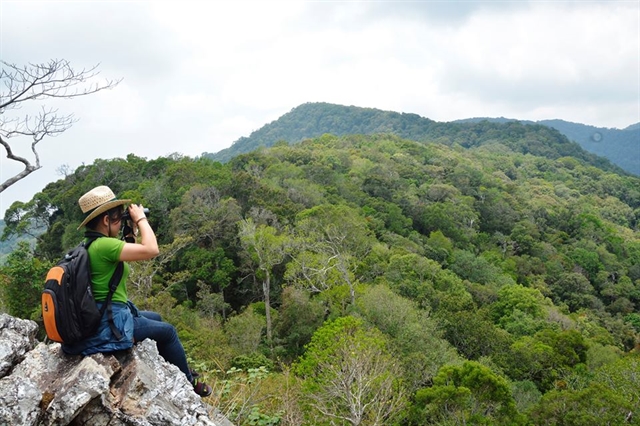
An individual grey-shanked douc langur (Pygathrix cinerea), one of the world’s 25 Critically Endangered primates, is found living in a forest of Quảng Nam Province. Photo courtesy of Ái Tâm
Since the government’s Decision 628 – an action plan for the protection of the primate species in Việt Nam– was issued in 2017, a total of 684 endangered douc langurs, including 86 grey-shanked douc langurs (Pygathrix cinerea), one of the world’s 25 Critically Endangered primates, have been captured by rangers and authorities in 80 illegal hunting and wildlife trafficking cases.
However, a report by ENV, an NGO focused on wildlife protection, showed that only 30 per cent of total poaching violations in Việt Nam were discovered, while 70 per cent were unknown, meaning that the number of the langurs hunted in the forest was unclear.
Biologists, conservationists and experts shared the report at a conference on the conservation activities on endangered primates in the central provinces Quảng Nam, Quảng Ngãi, Bình Định, Phú Yên, Gia Lai and Kon Tum, and discussed further actions from 2025 to 2030.
They agreed that illegal wildlife hunting, the expansion of coffee and log farms, poor management and planning on the protection of the primates species in the six provinces had been raising threats to the conservation of endangered primates.

A log farm raises dangers of erosion after cutting every five years. The forest area in the region has been narrowed, leaving space for profitable timber, coffee, pepper and rubber plantations. VNS Photo Công Thành
Expert Hà Thăng Long, head of the representative office of the Frankfurt Zoological Society in Việt Nam, said urgent action was needed for more effective protection of the langurs from becoming extinct in the six provinces where from 2,200 to 2,500 individuals are living in the primary forest or strictly protected nature reserves.
“A strategic management and protection plan on the grey-shanked douc langur in nature outside of the protected special-use forest have been built at the six localities, but there is a lack of funds and poor cooperation in sharing information and data on the existence of the langurs among the six local authorities,” Long said.
“The expansion of log and coffee farms in the primary forest and control on illegal wildlife trafficking and hunting in the core zone of nature reserves have sped up series threats to the existence of the grey-shanked douc langur and other primates species.”

An expert checks a forest area of Kon Ka Kinh National Park in Gia Lai Province. The park is home to 800 grey-shanked douc langur (Pygathrix cinerea). Photo courtesy of Nguyễn Thị Tịnh
Long explained the separation of forest areas due to the construction of roads and hydropower plants would raise more dangers to the langurs.
A report from the Ministry of Agriculture and Rural Development unveiled that the central region lost 34,000ha of forest due to illegal logging and land clearance for coffee, rubber and acacia plantations.
The forested area had dropped by 180,000ha, of which 112,000ha had been destroyed or occupied by the expansion of other crop plantations, and 37,000ha for building hydropower plants and roads between 2010-15, the report detailed.
Nguyễn Thị Thu Hiền, a member of the three-monkeys conservation, an NGO, said since the first grey-shanked douc langur individual was rescued in 1995 and then described by German primatologist Tilo Nadler in 1997, 62 Critically Endangered langurs including 26 babies, had been seized from illegal trafficking and hunting cases at the Cúc Phương-based Endangered Primate Rescue Centre.
She said a rescued baby langur meant that its mother or father had been killed.
Hiền said 72 grey-shanked douc langurs were rescued from trafficking and hunting violations in Kon Tum, Quảng Ngãi and Bình Định from 2010 to 2020.
She said more reserves of primate species and a survey on the existence and habitat of the grey-shanked douc langurs in the region were needed.
Gia Lai’s Kon Ka Kinh National Park and Kon Tum’s Kon Plong forest are the two largest homes of Critically Endangered langurs with about 1,300.
Oliver Wearn from Fauna & Flora International (FFI) said a survey from experts and researchers working at FFI in 2015-16 found that Kon Plong forest sheltered from 31 to 35 herds of grey-shanked douc langurs with a population of more than 500.
He said the langurs would be found living in the forest by local communities from 2000, yet a protection plan for the langurs was built at Kon Plong.
He said Critically Endangered langurs had been facing different threats such as forest degradation, habitat separation, log exploitation and road construction.
He said FFI and partners had cooperated with local authorities and forest owners to support technical and sustainable management plans on forests, build surveys on wildlife hunting and trafficking and assess human resources training.
Trần Hữu Vỹ, director of the Centre of Biodiversity Conservation, said residents in Tam Mỹ Tây Commune in Quảng Nam’s Núi Thành District were engaged in the voluntary protection of a herd of grey-shanked douc langurs from 1997.

A poster of a red-shanked douc langur is displayed calling for protection of the primates species in Việt Nam. VNS Photo Công Thành
The province plans to expand the protected area to 100ha from 30ha and link it with the Phú Ninh protected forest to build a nature reserve in the future.
Lê Khắc Quyết from FFI also said it needed to speed up protection plans for the primates species in Việt Nam, and actions must be urgently made to save the endangered primates from extinction.
He said various plans for primates protection in 2025 had been slowly implemented, including building three primates rescue centres, reducing 70 per cent of hunting cases and 70 per cent of rangers being trained in primate protection.
Experts also said that sustainable management and exploitation of forestry products in forests and promoting education among local communities in the reserves would be seen as positive solutions for the protection of endangered primates species in the central region. VNS
OVietnam